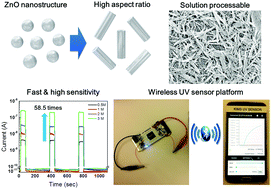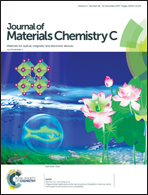Aspect ratio-controlled ZnO nanorods for highly sensitive wireless ultraviolet sensor applications†
Abstract
Structurally controlled zinc oxide (ZnO) nanorods (NRs) were synthesized for ultraviolet (UV) sensing. Concentrations of the zinc precursor and base were controlled to characterize the effects of seeding and growth reaction concentration on the ZnO nanostructures. By increasing the growth concentration, high aspect ratio (maximum 27.3) ZnO NRs were obtained. In addition, we confirmed that the seeding solution concentration was another important factor for ZnO NR synthesis. The formation of ZnO crystal structures was confirmed using X-ray diffraction (XRD), and the structure was well matched to the wurtzite ZnO crystal structure. The morphologies of the crystal structures, including their diameter and length, were determined from field emission-scanning electron microscopy (FE-SEM) and transmission electron microscopy (TEM) images. The optoelectronic properties were characterized by measuring the photocurrent values during UV sensing. The measured current of the ZnO NRs with a high aspect ratio was 58.5 times higher than that of the ZnO nanoparticles when the applied potential was 10 V and the UV intensity was 840 μW cm−2. To fabricate a wireless smartphone-connected UV sensor platform, a lithium-ion battery, a circuit including a Bluetooth module, a smartphone application, and a developed ZnO NR UV sensor were developed and integrated together. Based on the linear relationship between the photocurrent and UV intensity, the UV irradiation was confirmed in real time on the smartphone screen.


 Please wait while we load your content...
Please wait while we load your content...